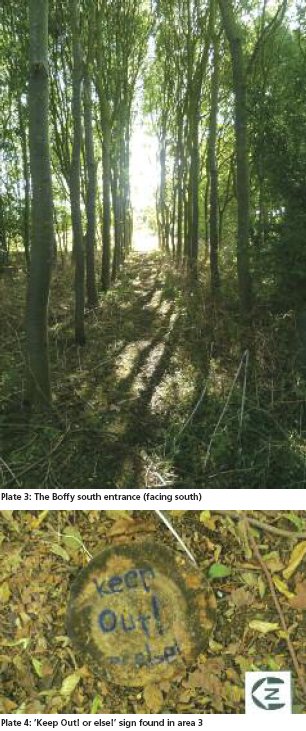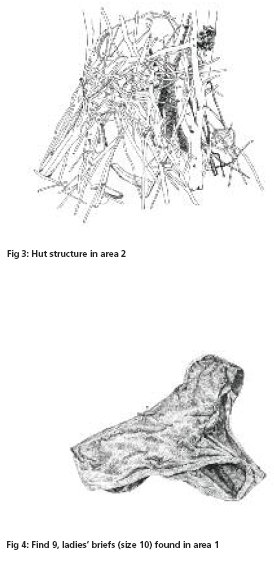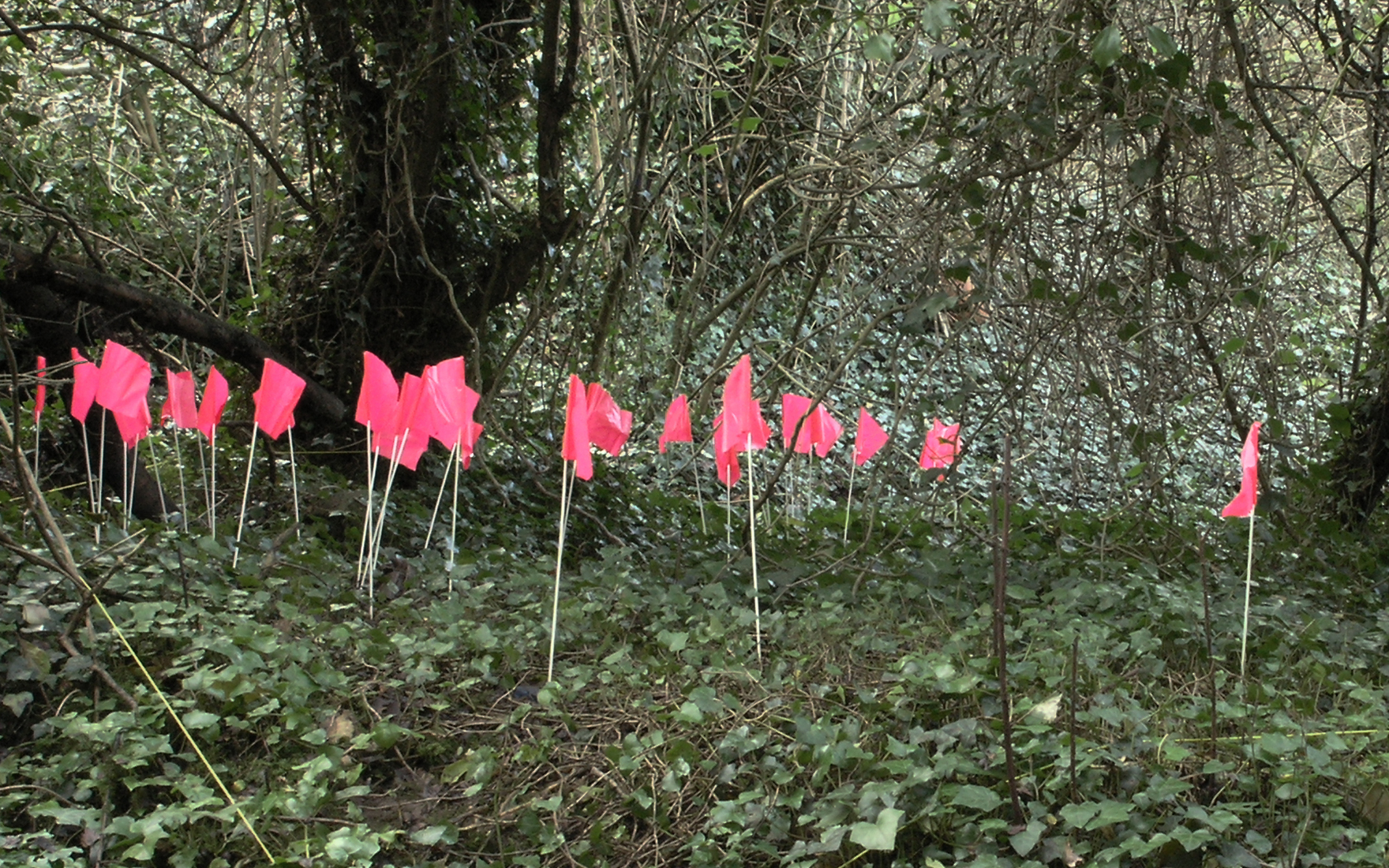“Over the course of 12 months, beginning September 2012, eight sites located within and around Letchworth Garden City were explored and narrowed down to four (Sites 1, 2, 3 and 6). These were then ‘excavated’ as part of the Hidden Landscapes Project.”
And so begins Christina Bryant’s report, in which the artist-investigator provides a painstaking account of these four sites in and around the proto-utopian Letchworth Garden City, laid out in 1903 by Raymond Unwin according to the principles of Ebenezer Howard. Site 1: The Pudding Basin; Site 2: The Boffy; Site 3: Roman Camp (The Quarry); Site 6: Placebo Underpass.
Subtitled “Discovering the Hidden Wilderness of Letchworth Garden City”, Bryant’s extraordinary work twists between a structure of arch officialdom and something stranger, and more personal. The project is presented, by and large, within the stylistic confines of the local council document. Co-ordinates, tables of finds, illustrations, charts, figures: all combine to provide the veneer of seriousness that such reports demand. Irony, however, has always already infiltrated: the more strenuously gravitas is asserted, the more silly it seems, barely even a parody of scientific research, its repetitions and conventions. The truth, though, is no laughing matter, not when all documents aspire to the condition of science.
The truth is no laughing matter,
not when all documents aspire to the
condition of science.
At the same time is an undercurrent. The passive voice of the second sentence gives way swiftly to an I, the oft-suppressed voice of the researcher, surfacing periodically. We’re told that the focus of the project is on those sites that lie “just beyond the surveillance and regulation of the dominant authority”. Here perhaps is where the I comes in, no longer marginalised by a particular privileging of objectivity. But not yet giving itself up to wildness. The I not only undercuts, but underpins – reinforcing by adding depth and alternative strategies of study.
And yet… Bryant affirms her debt to Arts Council England, to a community grant from Heritage Foundation, Letchworth Garden City and to North Hertfordshire District Council. It might therefore be interesting to ask to what extent Hidden Landscapes Project itself forms part of the tools of surveillance of the dominant authority. And to what extent does Bryant’s work have to remain outside, running amok?
Bryant’s own conclusion comments on both illegal behaviour (fly-tipping at Site 3; graffiti at Site 6; bonfires at Sites 1 and 2) and “extensive evidence indicative of a creative drive”. The phrase “SEE ME!” is, for Bryant, both “simple” and “poignant”, the work of an “artist”, a fellow expressive I.
“These places, hidden between our urban and rural landscape, contain many mysteries,” she writes. “Their concealment and complexity provide a space where urges, identities and relationships can be explored, that in more socially ordered spaces would be restricted.”
We’ve been lucky enough to republish an extract from Hidden Landscapes Project below.

Site 2: The Boffy
(Norton Well) (NGR: TL 210 352)
The Boffy has a strong personal connection to me and sits quite vividly in my own memory of childhood adventure. This place, distant from adult influence, both alluring and terrifying in equal measure, gave rise to horror stories that, on my return for this project, I discover have endured in their effect. The Boffy is the furthest from the town (half a mile away) and also the largest (approximately 230 metres in length). The field on which The Boffy is situated has been recorded on the National Monument Record (no. 365779) detailing an early medieval inhumation cemetery.
I came to this site revisiting a place I went to in childhood. As an adult I returned in October 2012 and spent a week here mapping, excavating and drawing.

Site Description
The Boffy is a group of trees located downstream from the local sewage plant, adjacent to Pix Brook. Found at the site’s centre is ‘Norton Well’ (as it is labelled on the OS map) that trickles out as a small stream and joins the brook to the north. Hidden from view of any houses, The Boffy sits quite invisibly at the edge of a crop field at the bottom of a hill.I enter from an unofficial footpath to the south (area 1) and walk through a line of trees (plate 3). From the main pathway, approximately 20 metres along, I find clearings that divert off into less trodden territory to the east of the site. As I navigate my way, crunching over leaves and twigs and weaving through tall stinging nettles, I find myself entering a tall church-like canopy of trees, standing in almost perfect linear formation. At ground level all is still, but high up over my head the branches sway and crack and knock in a constant rhythmic motion that gives rise to a feeling of exposing isolation. I feel I’ve travelled much further than I have. Around the base of two of these trees (area 2), I find a gathering of sticks that forms a hut-type structure (fig 3).
As I circle my way round it to get a better view, I acknowledge the labour required to construct it. A larger tree trunk (including its stump) has been secured between two trees and from this trunk, smaller, thinner branches have been used to weave the two sides, leaving just a small entrance at one end. Inside lies a yellow length of rope, looped and knotted (find 60).
Beyond this feature, approximately 20 metres to the north, I find an area of activity (area 3) and the site of a bonfire. This is made up of both charred wood and fresh wood that seems to have been gathered and arranged but, at this point, not burnt. Over the course of my time at The Boffy, a branch structure is constructed (most probably over the weekend at a time I did not visit). Within this area I also stumble across a ‘Keep Out! or else!’ sign written on a sawn piece of log (plate 4). At this discovery, I feel my role at The Boffy challenged and distorted somewhat. I move from lone explorer to intruder and become haunted by a slight paranoia.
Find Category Analysis
The highest number of finds from one category is drink containers: all but one of these found in area 3. Out of the 14 drink container finds, 10 are alcohol-related, mainly made up of glass shards from bottles. The main location for these is in area 3 around the bonfire with many showing signs of melting.
Area 1 shows an unusually high concentration of medical and personal hygiene-related items as well as the only clothing find (fig 4), and there is a high concentration of finds from the ‘Ammunition’ category found in area 4.

Discussion
Activities indicated by the finds include bodily care, social gathering, eating and drinking and, particularly north of the stream, shooting (probably game). The constructed features, which are mostly made from sticks, logs and branches (presumably acquired from the site), include two bridges, a log seat (area 4), a branch structure (area 3) and a hut structure (area 2), and are indicative of attempts made to shape and possess areas of the site. The site appears to be divided into different areas, identifiable by varying characteristics created by the users. It would appear that the bonfire in area 3 is a centre for social activity and is occupied by a number of people most likely to be around adolescence.
This assumption is made due to the high quantity of alcohol-related finds, indications of excitable or raucous behaviour, the number of broken and burnt artefacts, and a drinks can with pellet holes (find 51) possibly made by a ball-bearing gun.
Area 2, however, produced fewer finds and this, I assume, is due to the fact that the users were much more focused on the making of the hut. It would indicate this was made at a separate time, by another smaller group of potentially younger inhabitants. The ‘Keep Out! or else!’ sign in area 3 suggests a possible dispute over territory, presumably between two rival groups.
Area 4 seems much more likely to be inhabited on frequent occasions by the same lone person. The log seat has been made to last for some time. It has possibly been used as a place from which to shoot game, due to the high concentration of empty shotgun cartridges near it. This person appears to be much more of a ‘loner’ type figure, spending lengths of time stalking animals with a shotgun and spade (find 78) in a more isolated part of The Boffy.


hiddenlandscapesproject.wordpress.com
christinabryant.co.uk

